PATH (Toronto)
PATH is a network of underground pedestrian tunnels, elevated walkways, and at-grade walkways connecting the office towers of Downtown Toronto, Ontario, Canada. It connects more than 70 buildings via 30 kilometres (19 mi) of tunnels, walkways, and shopping areas. According to Guinness World Records, PATH is the largest underground shopping complex in the world, with 371,600 square metres (4,000,000 sq ft) of retail space[1] which includes over 1,200 retail fronts (2016).[2] As of 2016, over 200,000 residents and workers use the PATH daily with the number of private dwellings within walking distance at 30,115.[2]
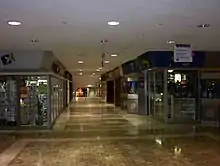 The PATH from under First Canadian Place | |
| Location | Toronto, Ontario, Canada |
|---|---|
| Opening date | 1900 – first pedestrian tunnel in Toronto 1960–70s – construction begins of underground shopping concourses and linkages 1987 – City becomes coordinating agency of network |
| Management | City of Toronto government (coordinating agency) |
| No. of stores and services | 1,200 |
| Total retail floor area | 371,600 m2 (4,000,000 sq ft) |
| No. of floors | 1 |
| Parking | 20 parking garages |
| Website | www |
The PATH network's northern point is the Toronto Coach Terminal at Dundas Street and Bay Street, while its southern point is Waterpark Place on Queens Quay. Its main north–south axes of walkways generally parallel Yonge and Bay Streets, while its main east–west axis parallels King Street.
There is continuous expansion of the PATH system around Union Station. Two towers being built as part of CIBC Square will be linked to the PATH, extending the PATH to the east to cross over Yonge Street by a pedestrian bridge into the Backstage Condominium building (Esplanade and Yonge corner), giving closed access to Union Station, Scotiabank Arena, and other buildings in Toronto's Financial District.
History
Early pedestrian tunnels
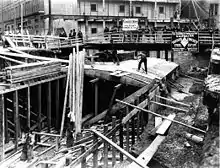
In 1900, the Eaton's department store constructed a tunnel underneath James Street, allowing shoppers to walk between the Eaton's main store at Yonge and Queen streets and the Eaton's Annex located behind the (then) City Hall. It was the first underground pedestrian pathway in Toronto and is often credited as a historic precursor to the current PATH network. The original Eaton's tunnel is still in use as part of the PATH system, although today it connects Toronto Eaton Centre to the Bell Trinity Square office complex on the site of the former Annex building.
Another original underground linkage, built in 1927 to connect Union Station and the Royal York Hotel, remained an integral part of the PATH network for many years until it was replaced by a newer connection between the Royal York Hotel and Royal Bank Plaza, which continues onward to Union Station.[1]
Expansion
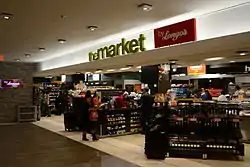
The network of underground walkways expanded under city planner Matthew Lawson in the 1960s. Toronto's downtown sidewalks were overcrowded, and new office towers were removing the much-needed small businesses from the streets. Lawson thus convinced several important developers to construct underground malls, pledging that they would eventually be linked. The designers of the Toronto-Dominion Centre, the first of Toronto's major urban developments in the 1960s (completed in 1967), were the first to include underground shopping in their complex, with the possibility of future expansion built in. The city originally helped fund the construction, but with the election of a reform city council, this practice ended. The reformers disliked the underground system, agreeing with Jane Jacobs' notion that an active street life was important in keeping cities and neighbourhoods vital and that consumers should be encouraged to shop on street level stores rather than in malls (whether they be above ground or below); however, the system continued to grow, as developers bowed to their tenants' wishes and connected their buildings to the system. This also converted low-valued basements into some of the most valuable retail space in the country.
The next expansion of the network occurred in the early 1970s with the construction and underground connection of the Richmond-Adelaide Centre office tower with the Sheraton Centre hotel complex.
21st century
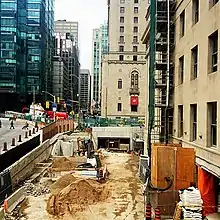
Construction of the PATH tunnel north from Scotia Plaza through the Bay Adelaide Centre started in the fourth quarter of 2007. Completion of this section closed the last remaining gap in the north–south route through PATH that parallels Yonge Street, thus eliminating the need to double back from Bay Street to get between buildings located on the eastern edge of PATH.
In 2011, the City of Toronto released a long-term expansion plan for the PATH, developed by Urban Strategies Inc.[3][4] As part of the expansion plan, there will be 45 new entry points, and the walkway expanded to as long as 60 kilometres (37 mi) when changes are completed.[5]
In August 2014, a major southward expansion of the PATH network brought it closer to the Toronto waterfront, with the opening of a covered pedestrian bridge connecting Scotiabank Arena south to WaterPark Place on Queens Quay (crossing the Lake Shore Boulevard / Gardiner Expressway corridor and Harbour Street).[6]
The city of Toronto constructed a 300-metre (980 ft), CA$65-million tunnel connecting Union Station to Wellington Street, the first publicly owned segment of the 370,000-square-metre (4,000,000 sq ft) PATH subterranean shopping district. Toronto planners have begun work to guide future PATH development and ensure PATH link construction is included in basement levels of key new buildings.[7]
The network was particularly hard-hit during the COVID-19 pandemic in Toronto, with BNN Bloomberg calling the area a "ghost town". The pedestrian system's narrow halls in some locations were noted as a particular challenge, even once downtown employees returned to work. The Toronto Financial District Business Improvement Area has planned various movement modifications to the space for future use.[8]
2020
In early November 2020, a connection was opened between the Maple Leaf Square complex (via the basement-level Longo's supermarket) and ÏCE Condominiums at York Centre.[9] On December 5, 2020, the new Union Station Bus Terminal was opened within the new CIBC Square complex and connected via a skywalk to the Scotiabank Arena.[10]
Design
PATH provides an important contribution to the economic viability of the city's downtown core and is also used to supplement sidewalk capacity in downtown Toronto.[11] The system facilitates pedestrian linkages to public transit, accommodating more than 200,000 daily commuters and thousands of additional tourists and residents en route to sports and cultural events. Its underground nature provides pedestrians with a safe haven from the winter cold and snow, as well as relief from the summer heat and humidity.[12]
Coordination and signage
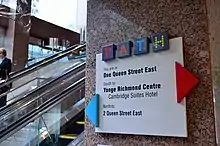
In 1987, City Council adopted a unified wayfinding system throughout the network. The design firms Gottschalk+Ash International and Muller Design Associates were hired to design and implement the overall system in consultation with a diverse group of land owners, City staff and stakeholders. A colour-coded system with directional cues was deployed in the early 1990s. Within the various buildings, pedestrians can find a PATH system map, plus cardinal directions (P (red) for south, A (orange) for west, T (blue) for north, H (yellow) for east) on ceiling signs at selected junctions.
The signage can be hard to find inside some of the various connected buildings. Building owners concerned about losing customers to neighbouring buildings insisted any signage not dominate their buildings or their own signage system. The city relented and the result is the current system. Many complain the system is hard to navigate.[13]
Connected facilities
More than 50 buildings or office towers are connected through the PATH system. It comprises twenty parking garages, five subway stations, two major department stores, two major shopping centres, six major hotels, and a railway terminal. The CN Tower, Ripley's Aquarium of Canada, and Rogers Centre are connected via an enclosed elevated walkway, called the SkyWalk, from Union Station, although the walkway does not have indoor connections to these attractions.
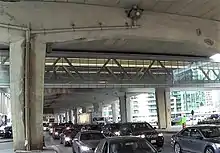
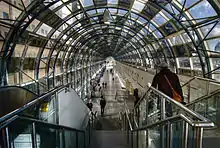
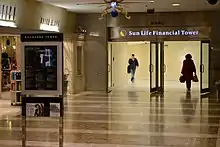

- 1 King Street West
- 1 Queen Street East
- 1 York
- 10 Dundas East
- 150 York
- 2 Queen Street East
- 19 Grand Trunk
- 22 Front Street West
- 25 Lower Simcoe
- 55 University
- Atrium on Bay
- Bay Adelaide Centre
- Bell Trinity Square
- Brookfield Place
- Canadian Broadcasting Centre
- CIBC Square
- Citibank Place
- Commerce Court
- Design Exchange
- Dundee Place
- Exchange Tower
- EY Tower
- Federal Building
- First Canadian Place
- Four Seasons Centre
- Hilton Hotel
- Hockey Hall of Fame
- HSBC Bank of Canada Building
- Hudson's Bay Queen Street
- ÏCE Condominiums at York Centre
- ING Tower
- Maple Leaf Square
- MetLife Place
- Metro Hall
- Metro Toronto Convention Centre
- Munich Re Centre
- Richmond-Adelaide Centre
- RBC Centre
- Roy Thomson Hall
- Royal Bank Plaza
- Fairmont Royal York
- Ryerson University
- Scotia Plaza
- Scotiabank Arena
- Sheraton Centre Toronto Hotel
- Simcoe Place
- Southcore Financial Centre
- Sun Life Centre
- Telus Tower
- 10 Dundas East
- Thomson Building
- Toronto City Hall
- Toronto-Dominion Centre
- Toronto Eaton Centre
- Toronto Coach Terminal
- Toronto subway stations:
- Telus Harbour
- Union Station
- Union Station Bus Terminal
- Victory Building
- Yonge–Dundas Square
- Yonge–Richmond Centre
References
- "PATH – Toronto's Downtown Underground Pedestrian Walkway". Archived from the original on 2014-06-20.
- Hume, Grant (Feb 2016). "Downtown PATH makes North American history as a mall" (Feb 2016, page 6). The Bulletin (Local Toronto Newspaper).
- Mills, Carry (2012-09-06). "Toronto mulls plan to expand world's largest underground shopping complex". Retrieved 2016-01-14.
- "PATH Master Plan Study". City of Toronto. Archived from the original on 2016-01-12. Retrieved 2016-01-14.
- Marcus, S: "The Ryersonian", page 1 Archived 2009-03-19 at the Wayback Machine, 5 Archived 2009-03-19 at the Wayback Machine. Ryerson University School of Journalism, September 26, 2007
- "PATH expands with new pedestrian bridge to waterfront". CTV News. 2014-08-16. Retrieved 2016-01-14.
- Kryhul, Angela (June 29, 2010). "Toronto Shines a Light on Underground PATH". The Globe and Mail. Toronto. Retrieved August 6, 2011.
- Steven Frank; Sandra Mergulhao; Doug Alexander (31 May 2020). "Toronto's PATH network faces bleak future with bankers MIA". BNN Bloomberg. Toronto ON: BellMedia. Retrieved 1 June 2020.
- "PATH Network expansion Post 472". Urban Toronto. November 10, 2020. Retrieved December 5, 2020.
- Money, Scott (November 16, 2020). "Toronto's new Union Station Bus Terminal gets ready to open – Here's what you need to know to get on the bus". Metrolinx. Archived from the original on November 25, 2020. Retrieved November 26, 2020.
- "Incrase space for walking" (PDF). Downtown Mobility Strategy. City of Toronto. April 2018. p. 40. Retrieved 25 August 2019.
- "PATH – Toronto's Downtown Underground Pedestrian Walkway – Getting Here & Around – Visitor Information Services | City of Toronto". .toronto.ca. Archived from the original on 2014-06-20. Retrieved 2014-06-02.
- Lakey, Jack (August 26, 2009). "For Some Visitors, It's a PATH That Leads Nowhere". Toronto Star. Retrieved August 6, 2011.
External links
| Wikimedia Commons has media related to PATH (Toronto). |